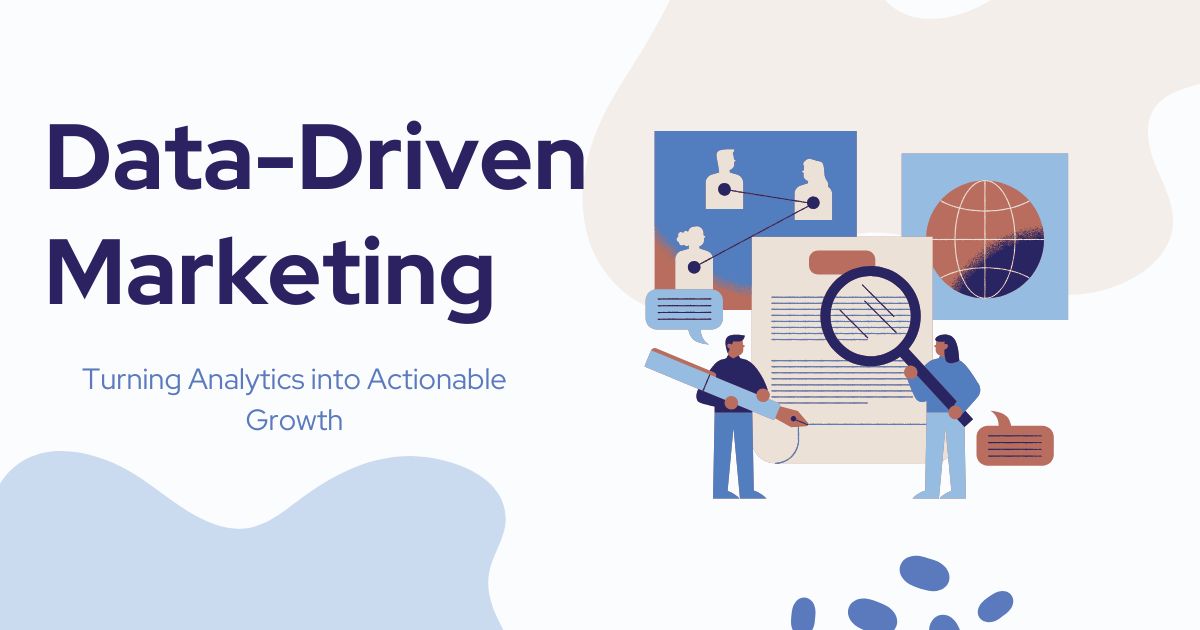
Data-driven content marketing uses analytics to guide strategy, improve engagement, and boost conversions while supporting creative content.
In content marketing, creativity often takes the spotlight. We focus on compelling stories, beautiful designs, and catchy headlines. While these elements are crucial, they are only one part of the success equation. The other, often overlooked, part is data. A data-driven approach to content marketing moves you from guessing what your audience wants to knowing what they need.
Relying on data removes the guesswork that leads to wasted resources and missed opportunities. Instead of creating content based on assumptions, you can use analytics to make informed decisions that resonate with your audience and deliver measurable results. This guide will walk you through how to implement a data-driven strategy, from identifying your key metrics to optimizing your content for maximum impact. By the end, you’ll have a clear framework for creating content that not only engages but also converts.
What is Data-Driven Content Marketing?

Data-driven content marketing is the practice of using analytics, insights, and performance metrics to guide every step of your content strategy. From planning topics and creating content to promoting it and analyzing results, data drives smarter decisions. Instead of relying on assumptions or guesswork, you base your strategy on measurable evidence.
This method helps you understand:
-
Your audience: Their demographics, interests, browsing habits, and challenges.
-
Content preferences: Which topics, formats, and platforms capture attention.
-
Traffic sources: Which search terms, social channels, and referral sites bring visitors.
-
User behavior: What actions they take, such as subscribing, downloading resources, or making purchases.
By building your content strategy around data, you create a feedback loop that continuously improves your results. Each blog post, video, or social update generates insights that guide the next piece of content. This approach ensures your marketing is targeted, efficient, and optimized for engagement, conversions, and overall business growth. When executed well, data-driven marketing is a game-changer, helping you reach the right audience at the right time with content that truly resonates.
Why a Data-Driven Approach is Non-Negotiable

Adopting a data-driven mindset isn’t just a trend—it’s a strategic shift that gives businesses a strong competitive advantage. Teams that leverage analytics and insights can unlock several key benefits that improve marketing efficiency and outcomes.
Deeper Audience Understanding
Data provides a clear window into your audience’s world. Analytics tools can reveal their location, the devices they use, and the times they are most active online. By tracking which blog posts they read, which videos they watch, and which emails they open, you can build a detailed picture of their interests and challenges. This deep understanding allows you to create content that speaks directly to their needs, building trust and establishing your brand as a valuable resource.
Analytics tools reveal user location, devices, and activity times. By tracking which blog posts they read, which videos they watch, and which emails they open, you can build a detailed picture of their interests and challenges. This deep understanding allows you to create content that speaks directly to their needs, building trust and establishing your brand as a valuable resource.
For a complete roadmap, see data-driven decision making in marketing: a roadmap to success.
Improved Content Performance
When you know what works, you can do more of it. Data-driven marketing helps you identify your top-performing content so you can replicate its success. For example, if you notice that “how-to” guides consistently receive high traffic and engagement, you can prioritize creating more of them. Likewise, if a particular topic generates a lot of shares on social media, you can explore it further with follow-up articles or webinars. This targeted approach ensures your efforts are focused on content that delivers real results.
For insights on content strategy execution, check out digital content marketing: your complete guide.
Higher Return on Investment (ROI)
Every piece of content requires an investment of time, money, and creativity. A data-driven strategy ensures that investment pays off. By tracking metrics like conversion rates, cost per acquisition, and customer lifetime value, you can directly measure the financial impact of your content. This allows you to justify your marketing budget and demonstrate the value of your work to key stakeholders. Over time, you can optimize your spending by investing in the channels and content types that deliver the best ROI.
Tracking metrics like conversion rates, cost per acquisition, and customer lifetime value ensures every content investment pays off.
For practical guidance, explore use data-driven marketing to grow your business.
How to Implement a Data-Driven Content Strategy
Transitioning to a data-driven approach involves a series of deliberate steps. Here’s a breakdown of how to get started.

Set Clear and Measurable Goals
Before you can measure success, you need to define what it looks like. Your goals should align with your broader business objectives. Are you trying to increase brand awareness, generate leads, or drive sales?
Each goal should be tied to specific Key Performance Indicators (KPIs). For example:
- Goal: Increase brand awareness.
- KPIs: Website traffic, social media reach, brand mentions.
- Goal: Generate leads.
- KPIs: Form submissions, email subscribers, download counts.
- Goal: Drive sales.
- KPIs: Conversion rate, revenue generated from content.
Gather the Right Data
With your goals established, the next step is to collect the data that will help you track your KPIs. There are many tools available, and the ones you choose will depend on your goals and budget.
- Website Analytics: Tools like Google Analytics are essential for tracking website traffic, user behavior, and conversions.
- SEO Tools: Platforms like Semrush, Ahrefs, and Moz provide insights into keyword rankings, backlink profiles, and competitor performance.
- Social Media Analytics: Each platform (Facebook, LinkedIn, Instagram, etc.) has its own built-in analytics to track engagement, reach, and follower growth.
- Customer Relationship Management (CRM): Systems like HubSpot or Salesforce can help you track how leads from your content move through the sales funnel.
Analyze Your Data for Insights
Collecting data is only the first step. The true value comes from analyzing it to uncover actionable insights. Look for patterns, trends, and user behavior across your website and marketing channels.
- Which blog posts have the highest page views and time on page?
- What keywords are driving the most organic traffic to your site?
- Which social media channels generate the most engagement?
- What percentage of your blog readers sign up for your newsletter?
Use these insights to answer important strategic questions. If a post gets high traffic but also a high bounce rate, it may not meet visitor expectations. If another page converts well, study its layout, call-to-action, and topic to understand why it works. By turning raw data into clear patterns and actionable steps, you can optimize your content and campaigns more effectively, creating a stronger foundation for analytics and data-driven marketing.
Apply Insights to Your Content Creation
Now it’s time to put your insights into action. Use what you’ve learned to inform your content creation process.
- Topic Ideation: Use keyword research and competitor analysis to find topics that your audience is actively searching for.
- Format Selection: If your data shows that video content gets high engagement on social media, consider creating more videos. If long-form blog posts drive conversions, invest in more in-depth articles.
- Content Optimization: For existing content, use data to make improvements. Update old posts with new information, add internal links to relevant pages, and optimize your meta descriptions to improve click-through rates.
Test, Measure, and Iterate
A data-driven strategy is not static; it’s a continuous cycle of improvement. Regularly review your performance against your KPIs and be prepared to adjust your approach.
Use A/B testing to experiment with different headlines, calls to action, and page layouts. For example, you could test two different email subject lines to see which one gets a higher open rate. By constantly testing and measuring, you can fine-tune your strategy for optimal performance.
The Importance of Aligning Content With the Customer Journey
Not all content serves the same purpose. Some educates, some persuades, and some encourages action. Data identifies user stages—from awareness to consideration to decision—so you can craft content that meets them where they are.
Data helps you identify which stage users are in by analyzing their behavior. A visitor reading multiple educational blog posts is likely in the awareness stage, exploring solutions to a problem. Someone who downloads a buyer’s guide or compares product pages is further along in the funnel. With these insights, you can craft tailored content designed to meet users exactly where they are.
Aligning content with the customer journey ensures every interaction feels intentional. It also prevents gaps where potential customers lose interest because the content doesn’t meet their needs. When your content ecosystem supports the journey from start to finish—and your data confirms how users move through it—you create a smoother path to conversion and stronger long-term relationships.
The Role of Audience Segmentation in Data-Driven Content Marketing
One of the most powerful advantages of using data in content marketing is the ability to segment your audience with precision. Instead of treating your audience as a single homogeneous group, segmentation allows you to tailor your messaging to different subsets based on shared characteristics. These segments can be defined by demographics, behaviors, purchase history, engagement patterns, or even psychographic traits like motivations and values.
When you understand how different audience groups behave, you can craft content that speaks directly to their stage in the customer journey. For instance, new visitors may need educational, top-of-funnel content that introduces your brand, while loyal customers may respond better to in-depth guides, case studies, or exclusive offers. Data helps you identify which segment is interacting with which type of content so you can design more personalized experiences.
Segmentation also helps improve distribution. You can serve specific content to specific audiences through targeted email campaigns, remarketing ads, and personalized website experiences. This level of precision enhances relevance, improves conversions, and builds a deeper connection with your audience. Instead of shouting into the void, you’re speaking to the right people at the right time with the right message.
How Predictive Analytics Shapes Future Content Strategies

While traditional analytics focuses on understanding what has already happened, predictive analytics uses data, algorithms, and machine learning to anticipate what will happen next. This forward-thinking approach can transform your content strategy from reactive to proactive.
Predictive analytics can identify future trends, forecast audience behavior, and reveal the types of content that are most likely to succeed. For example, historical data might show that your audience engages with finance-related topics every November due to budgeting season. With predictive insights, you can plan content in advance and publish it at the most strategic time, maximizing visibility and engagement.
It also helps forecast content ROI. By analyzing patterns in past conversions, predictive models can determine which formats or subjects are most likely to drive future leads or sales. This enables marketers to invest their resources wisely, prioritizing the ideas that offer the highest potential impact.
Furthermore, predictive analytics enhances personalization. It can recommend content based on the likelihood a user will click, share, or purchase. This type of intelligent automation ensures that your audience receives content that matches their behavior and needs—creating smoother user journeys and increasing the chances of conversion.
Your Next Steps Toward Data-Driven Success
Adopting a data-driven approach can transform your content marketing from guesswork into measurable results. Using analytics and performance insights helps you understand your audience better. It also shows which content drives engagement and conversions.
Start by setting clear marketing goals and identifying key performance indicators (KPIs). Collect and analyze data from your website, social media, and email campaigns. Use these insights to improve content relevance, optimize campaigns, and guide future strategies.
Data-Driven Growth Marketing allows you to make smarter decisions, focus on high-impact opportunities, and increase ROI. By continually testing, measuring, and refining your strategy, you create a cycle of continuous improvement. Over time, this approach builds a more efficient, effective, and results-driven content engine.
Frequently Asked Questions (FAQ)
What if I don’t have a lot of data to start with?
Everyone has to start somewhere. If you’re new to content marketing, begin by setting up Google Analytics on your website. Even a few weeks of data can provide valuable insights into your most popular pages and traffic sources. You can also conduct simple surveys with your existing customers to understand their needs and preferences.
How often should I review my content marketing data?
The frequency of your analysis depends on the metric. It’s a good practice to check high-level metrics like website traffic and social engagement weekly. A more in-depth analysis of your KPIs and content performance should be done monthly or quarterly. This allows you to spot trends and make strategic adjustments without overreacting to small, daily fluctuations.
Can a data-driven approach stifle creativity?
Not at all. Data should empower creativity, not limit it. By understanding what your audience cares about, you can focus your creative energy on developing content that truly resonates. Data provides the “what,” while your creativity provides the “how.” It gives you a framework to ensure your brilliant ideas have the best possible chance of success.
How do I know which data actually matters for my content strategy?
It’s easy to get overwhelmed with data, but not all metrics are meaningful. Focus on metrics that align directly with your goals. If your objective is lead generation, track conversions, form submissions, and scroll depth. If your goal is brand awareness, prioritize impressions, page views, and engagement. The right data depends entirely on what you’re trying to achieve.
Do small businesses really need a data-driven content strategy?
Absolutely. In fact, small businesses often benefit the most because data helps them use their limited resources more efficiently. Instead of creating content blindly, small businesses can use data to understand exactly what their audience wants—making every piece of content more purposeful and impactful.
Is it possible to combine intuition with data?
Yes—and this combination often produces the best results. Data shows you the opportunities and patterns, while intuition guides creativity and storytelling. Use data to validate your instincts, refine your ideas, and ensure your content choices are grounded in evidence, not guesswork.
What tools do I need to get started with predictive analytics?
While advanced predictive platforms exist, you don’t need expensive tools to begin. Platforms like Google Analytics 4 already include predictive metrics such as purchase probability and churn likelihood. As your needs grow, tools like HubSpot, Salesforce Einstein, and Adobe Analytics offer more robust predictive features.
Leave a Reply